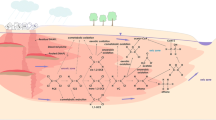Abstract
The Gibbs free energy of formation of chlorinated aliphatic compounds was estimated with Mavrovouniotis' group contribution method. The group contribution of chlorine was estimated from the scarce data available on chlorinated aliphatics in the literature, and found to vary somewhat according to the position of chlorine in the molecule. The resulting estimates of the Gibbs free energy of formation of chlorinated aliphatic compounds indicate that both reductive dechlorination and aerobic mineralization of these compounds can yield sufficient energy to sustain microbial growth.
Similar content being viewed by others
References
Ashworth RA, Howe GB, Mullins ME & Rogers TN (1988) Airwater partitioning coefficients of organics in dilute aqueous solutions. J. Hazard. Mater. 18: 25–36
Dawson RMC, Elliot DC, Elliott WH & Jones KM (1986) Data for Biochemical Research, 3rd ed. Clarendon Press, Oxford
Dean JA (1985) Lange's Handbook of Chemistry, 13th ed. McGraw-Hill, New York
Dolfing J (1990) Reductive dechlorination of 3-chlorobenzoate is coupled to ATP production and growth in an anaerobic bacterium, strain DCB-1. Arch. Microbiol. 153: 264–266
Dolfing J & Harrison BK (1992) The Gibbs free energy of formation of halogenated aromatic compounds and their potential role as electron acceptors in anaerobic environments. Environ. Sci. Technol. 26: 2213–2218
Dolfing J & Tiedje JM (1986) Hydrogen cycling in a three-tiered food web growing on the methanogenic conversion of 3-chlorobenzoate. FEMS Microbiol. Ecol. 38: 293–298
Dolfing J & Tiedje JM (1987) Growth yield increase linked to reductive dechlorination in a defined 3-chlorobenzoate degrading methanogenic coculture. Arch. Microbiol. 149: 102–105
Gossett JM (1987) Measurement of Henry's law constants for C1 and C2 chlorinated hydrocarbons. Environ. Sci. Technol. 21: 202–208
Helgeson HC (1992) Calculation of the thermodynamic properties and relative stabilities of aqueous acetic and chloroacetic acids, acetate and chloroacetates, and acetyl and chloroacetyl chlorides at high and low temperatures and pressures. Appl. Geochem. 7: 291–308
Holmes DA, Harrison BK & Dolfing J (1993) Estimation of Gibbs free energies of formation for polychlorinated biphenyls. Environ. Sci. Technol. 27: 725–731
Janssen DB, Keuning S & Witholt B (1987) Involvement of a quinoprotein alcohol dehydrogenase and an NAD-dependent aldehyde dehydrogenase in 2-chloroethanol metabolism inXanthobacter autotrophicus GJ10. J. Gen. Microbiol. 133: 85–92
Janssen DB, Scheper A, Dijkhuizen L & Witholt B (1985) Degradation of halogenated aliphatic compounds byXanthobacter autotrophicus GJ10. Appl. Environ. Microbiol. 49: 673–677
Leighton DT & Calo JM (1981) Distribution coefficients of chlorinated hydrocarbons in dilute air-water systems for groundwater contamination applications. J. Chem. Eng. Data 26: 382–385
Mackay DM & Shiu WY (1981) A critical review of Henry's law constants for chemicals of environmental interest. J. Phys. Chem. Ref. Data 10: 1175–1199
Mavrovouniotis ML (1990) Group contributions for estimating standard Gibbs energies of formation of biochemical compounds in aqueous solution. Biotechnol. Bioeng. 36: 1070–1082
Mavrovouniotis ML (1991) Estimation of standard Gibbs energy changes of biotransformations. J. Biol. Chem. 266: 14440–14445
Mohn WW & Tiedje JM (1990) Strain DCB-1 conserves energy for growth from reductive dechlorination coupled to formate oxidation. Arch. Microbiol. 153: 267–271
Thauer RK, Jungermann K & Decker K (1977) Energy conservation in chemotrophic anaerobic bacteria. Bacteriol. Rev. 41: 100–180
Zehnder AJB & Stumm W (1988) Geochemistry and biogeochemistry of anaerobic habitats. In: Zehnder AJB (Ed) Biology of Anaerobic Microorganisms (pp 1–38). John Wiley & Sons, Inc, New York
Author information
Authors and Affiliations
Rights and permissions
About this article
Cite this article
Dolfing, J., Janssen, D.B. Estimates of Gibbs free energies of formation of chlorinated aliphatic compounds. Biodegradation 5, 21–28 (1994). https://doi.org/10.1007/BF00695210
Received:
Accepted:
Issue Date:
DOI: https://doi.org/10.1007/BF00695210




